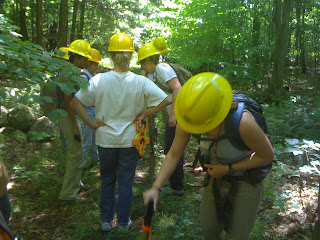
Week 8:
This, our second to last full week of LANDS was spent in the Burlington area beginning in earnest the final stages of our program: reports, final presentations and small team projects.

(Reed and Liz looking up communities)
(We used a pH test to help identify natural communities.)
 Monday:
Monday:We spent the first half of Monday at Raven Ridge, a conserved area in Huntington with Liz Thompson a UVM professor and co-author of Wetland, Woodland, Wildland a Guide to the Natural Communities of Vermont. Prof. Thompson helped us get comfortable classifying different types of forests and natural communities. After a delicious lunch with a beautiful view from the ridge, the interns split into groups to identify a natural community on our own.To end the day we explored a nearby sandplain forest to look for differences in natural communities in this area of glacial deposition. We looked for common species, examined tipped over trees and the exposed bedrock beneath, and dug a soil pit learning appropriate methods like lying down plastic to ensure all of the removed soil/matter is replaced.
(Zac showing us proper soil pit technique)
Tuesday morning Steve Libby joined us in the GreenHouse to give us a mini lecture on conservation easements and all the considerations and deliberations that go into creating these legal agreements. Tuesday also marked the beginning of our Small Team Projects (STPs). Groups of two and three interns have taken on small projects for various organizations (town forests, land trusts, etc.) to complete on our own. While a couple of interns went out into the field to meet with their client sponsors the rest of the crew stayed back at the GreenHouse to begin the final push to create reports for the summer’s surveys and to start thinking about our final presentation in two weeks. (Here Steve talks about property rights with some help from Zac and his bike)
(Rick relates the history of the Shelburne Pond property)
Wednesday:
We had another guest speaker today. Rick Paradis, a UVM professor and manager of the University’s natural areas took the crew out to one such area Shelburne Pond to continue the discussion around conservation and landscape protection. In particular, we discussed the many uses of the area and what the impacts of those activities are. Rick gave us a great overview of the history of that area from the glaciers that carved out much of Vermont to the family farms that used to surround the pond to the current issues concerning development and watershed protection. After leaving Rick, the crew continued to develop our various reports for the Green Mountain National Forest, State Department of Parks and Recreation and collect data for our STPs.
Thursday:
Thursday was much like the rest of the week except that we did not have a guest joining us. Some of us stayed in the office, but most broke up the day with some office time in the morning and then field time for the STPs. It is difficult to report on the individual projects since sometimes it’s tough to keep on top of your own! One team is creating a trail highlighting interesting natural features in the Montgomery Town Forest; one team is doing much the same in the Hinesburg Town Forest. The last two are performing natural community and plant inventories in conserved properties on Lake Champlain and in Richmond along the Huntington and Winooski rivers. It is refreshing to work with new partners and in slightly more professional capacity.
Friday:
More of the same: Small team projects are dominating our work today. This is our only full day out in the field so we all need to make the most of it. At the end of the day all crews looked excited but thoroughly exhausted and ready for a beautiful weekend before the real crunch time is upon us. Next week we need to finalize three full length reports, our individual STPs, and plan for the final presentation and the rest of LANDS. It is absolutely incredible that we’re nearly at the end of our program. The weeks flew by, just as promised. Thanks for reading and we hope to see you at our presentation August 30th from 6-8pm.






























